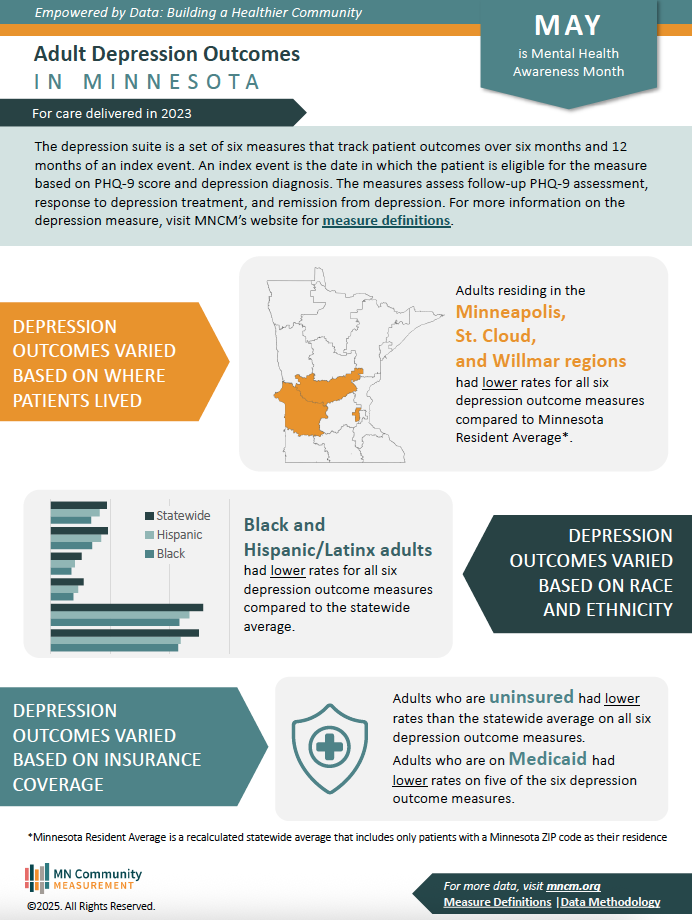Empowered by Data: Mental Health Impact on Diverse Communities
By Maegi Yang, MPH, Governance Manager

The importance of mental health continues to grow and has a profound impact on many people’s lives. Minnesota ranks 34th in prevalence of mental illness and 14th in accessibility to care in 20241. Although there is higher access to mental health care, Minnesota still ranks on the higher end for prevalence. May is Mental Health Awareness Month, emphasizing its significance and necessity to understand how our diverse communities are impacted. Here at MN Community Measurement (MNCM), we strive to dig deeper into the data and provide a greater understanding of what is going on not only within provider organizations, but the communities being served.
Spotlight on Disparities in Depression Suite of Measures
MNCM reports on the depression suite of measures, which includes six measures, tracking patient outcomes over six and twelve months from the initial PHQ-9 score and diagnosis. These measures evaluate follow-up PHQ-9 assessments, treatment response, and depression remission.
Analysis of the Adult depression data showed:
- Residents in the Minneapolis, St. Cloud, and Willmar regions had lower rates for all six depression outcome measures compared to Minnesota Resident Average
- Black and Hispanic/Latinx adults had lower rates for all six depression outcome measures compared to the statewide average.
- Adults who are uninsured had lower rates than the statewide average on all six depression outcome measures.
- Adults who are on Medicaid had lower rates on five of the six depression outcome measures.
Disparities exist in various communities, and it is common for individuals to exist within multiple of these areas.
Additional measures stratified by race and ethnicity can be found in our recently released report, Health Care in Minnesota: Summary Report on Quality, Disparities, and Cost, and in MNCM’s Statewide Performance Hub.
Why This Matters
It is essential to measure depression prevalence because it supports providers in guiding treatment and care and individuals in assessing mental, physical, and emotional wellbeing. The depression suite has notoriously been the most challenging measures for providers to address because of the complexity of identifying and tracking patients. Another layer that makes it hard to support individuals is the stigma surrounding mental health. It continues to exist in all communities, often leading to individuals delaying or not seeking care even if it was available2.
As a state, it is important for us to continue to identify at risk individuals and ensure there is continuation in monitoring them. Depression is not a linear line, which is why it is critical to assess patients for a prolonged period. However, it is equally important to have diverse resources available for patients, as no two patients or treatments are the same. This includes having cultural and linguistic resources, or support groups readily accessible3. By identifying the communities at risk, we can continue to address the gaps in care, resources, and our commitment to serve them to our highest potential.
Health Awareness Months
Does your organization have a special event or health initiative project that relates to one of these health topics? We’d love to feature it in our blog! Please submit information about your event/project using this form.
References:
